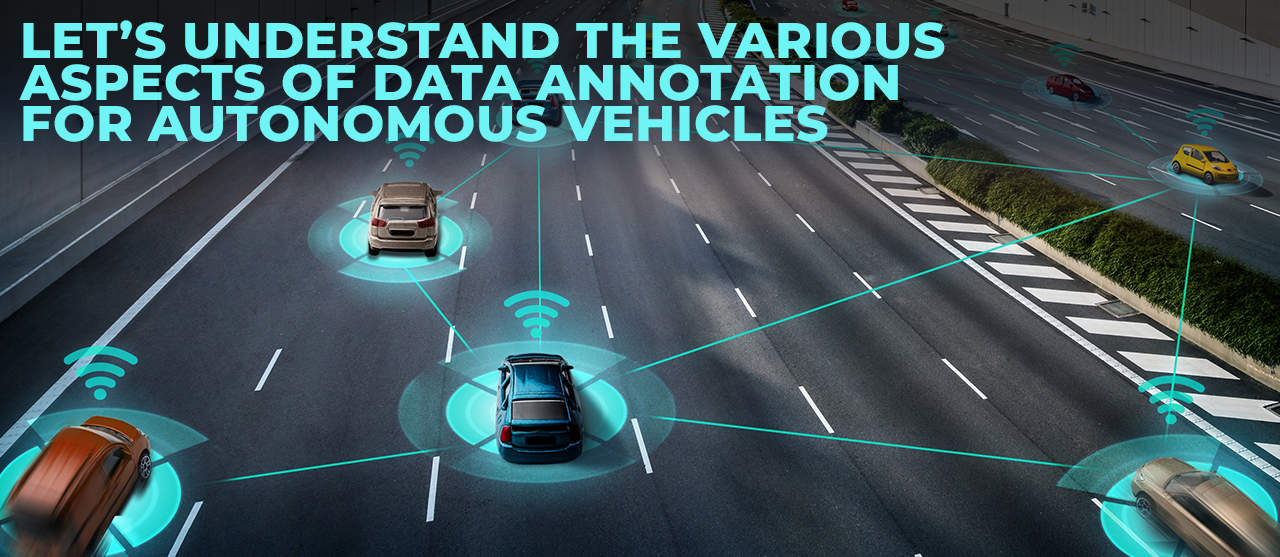
With autonomous vehicles (AVs) becoming mainstream, understanding how the data annotation process plays a significant role in their success is vital. Building safe driverless vehicles requires an autonomous algorithm with vital annotated data — reflecting upon the immense viability of machine learning (ML) in this space.
Videos and labeled images are pivotal in training driverless cars to recognize different objects coming in the way. Hence, precise data annotation is imperative for training machine learning models using supervised techniques.
Data Annotation & Labeling For Autonomous Vehicles Explained
According to Gartner, more than 740,000 cars will feature autonomous driving abilities by the end of 2023, primarily in North America, Western Europe, and China. To develop autonomous capabilities, algorithms must be trained to identify, track, and categorize objects to make informed decisions for safe navigation and path planning.
In essence, to ensure safe autonomous driving capacity, it is pertinent to have ML algorithms with labeled training datasets. The data includes videos and images of vehicles, pedestrians, cyclists, animals, traffic lights, potholes, construction sites, etc.
Rightfully, data annotation involves categorizing and labeling data to deploy AI applications successfully. Building a human-like ML or AI model requires a massive amount of quality data. Training data should be accurately categorized and annotated specifically to use cases to assist companies in developing and improving their AI implementations for enhanced UX.
Data annotation enables AI models to identify data correctly irrespective of the format – image, video, graphics, text, or mixed format. Based on the designated parameters and functionality of the AI model, it classifies data and proceeds with the tasks.
Role Of Data Annotation For Autonomous Vehicles
If you are wondering how annotated data works and how these algorithms facilitate driverless vehicles, read along:
1. Object Detection
Object detection is crucial for autonomous vehicles in order to avoid collisions. Data annotation accurately categorizes and labels object data, which can be used to train ML algorithms for object detection in real time.
2. Lane Detection
Self-driving systems are sophisticated and entail accurate and robust lane detection. Precise detection is the only way to help AVs drive safely on the roads and avoid accidents. Favorably, annotation-supported ML models ensure effective lane departure and trajectory planning. The algorithms achieve their goals through structure tensors, color-based features, ridge features, and bar filters.
3. Mapping & Localization
Mapping and localization significantly influence the road safety and path planning visibility of AVs. Here, multi-layer HD maps are indispensable for road planning, including vision-based, cloud-based, and landmark-based mapping. Furthermore, deep learning methods are deployed for long-term localization, motion estimation, and extraction.
4. Projection & Planning
Data annotation methodologies are essential for the effective planning and projection of autonomous vehicles. Planning involves mapping routes and locating them to connect the initiation point to the destination. The algorithms analyze the surroundings and plan trajectories, which can then be segmented into steps.
Types of Data Annotation Used For Autonomous Vehicles
1. Bounding Boxes
Bounding boxes are primarily used to track objects for vision as well as validate and test new sensors. For instance, self-driving vehicles use annotators to visualize surrounding vehicles with bounding boxes and label these vehicles. Labeling and annotation help algorithms understand the specifics of the vehicle, its looks, and its features. This ultimately helps increase automation efficiency and reduces cost.
2. Polygonal Segmentation
Driverless vehicles may come across various objects, irrespective of shapes and sizes, increasing the object detection complexity. To deal with it, they utilize polygons that define the shape of the object and its location precisely.
3. Semantic Segmentation
Semantic segmentation assists in ML model training and developing annotation requirements by designating image pixels to specific object classes. This versatile annotation technique makes it easier to differentiate between objects such as curbs, lanes, and roads and identify instances through the sequence.
4. 3D Cuboids
3D cuboids draw a cube to annotate specific targets or objects, highlighting the depth, width, and height of the object. This annotation is commonly utilized in path sequences to identify several types of objects moving on the road, such as cars, vans, trucks, pedestrians, and other automobiles.
5. Landmark & Key-point
This technique is used to determine small shapes and objects using several consecutive points that outline a particular object on an image or a video.
Accelerate AV Development With An Apt Partner
To accelerate AV development, car manufacturers should meet the increasing need for quality training datasets. They should update their stack with the evolving space of data annotation processes, technologies, and tools. Considering the fact that this dynamic landscape is frequently changing to become more efficient and better, it entails partnering with a data annotation expert to extend the capabilities of models.
At EnFuse, we support your annotation needs and provide a robust framework with seamless execution to accelerate autonomous vehicle development. We focus on facilitating highly intelligent platforms for annotating data and helping businesses make the most of ML and AI. Talk to a specialist today!
The Road Ahead
Driverless cars are now on the roads, modernizing travel. Indeed, the growth of AVs has encouraged massive innovation. As such, businesses in the space will consistently require high-quality and affordable data to support the process. As AVs depend on annotation to decode and understand surroundings, the demand for data annotation will continue to rise.

















Comment